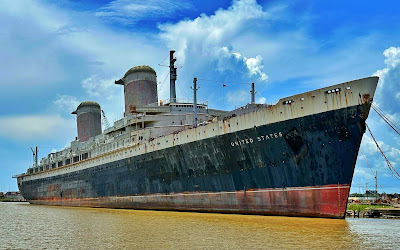Recent travel to visit with family found us in Mobile Alabama for a week with an opportunity to become temporary Mobilians and soak-up the history, food and ambiance of this coastal city. A boat ride of the delta estuary provided an opportunity to take-in the waterfront, port facilities and Austal Shipyard up-close and personal. Including this:
The SS United States is one of the most iconic ocean liners in American history. Designed during World War II and launched in the early 1950s, the ship represented American technological prowess and style.
The genesis for this ship began in the 1930s with naval architect William Francis Gibbs. He envisioned a fast, fireproof, and militarily convertible ocean liner that would showcase American maritime innovation. During World War II, seventy percent of all naval vessels were built to Gibbs and Cox designs. This included everything from Liberty ships, to destroyers, escort carriers and amphibious assault vessels. This contribution to the war effort strengthened his reputation and bolstered support for his ambitious passenger liner.
In 1950, the U.S. government—through the Maritime Commission—partnered with United States Lines to co-finance the construction of the ship with the understanding that it could be used as a troop carrier in wartime. The government contributed $50 million and the United States Lines contributed $28 million; adjusted for inflation - $928 million in today's dollars. Construction began at the Newport News Shipbuilding and Drydock Company in Virginia. The ship featured extensive use of aluminum and fireproof materials making her both lightweight and safe. She was designed to carry almost 2,000 passengers in luxury and over 15,000 troops in an emergency.
The SS United States was launched on June 23, 1951, and entered service on July 3, 1952. Her maiden voyage was a stunning success; shattering the transatlantic speed record crossing the Atlantic in 3 days, 10 hours, and 40 minutes—earning the coveted Blue Riband. Her return voyage was even faster.
Throughout the 1950s and 1960s, she was considered the epitome of American luxury and efficiency at sea. She hosted presidents, celebrities, business magnates, and immigrants. Notable passengers included Harry Truman, John F. Kennedy, Salvador Dalí, Marilyn Monroe, and Marlon Brando. Her speed, safety, and understated elegance set her apart from rivals.
 |
| Original Place Setting |
With the arrival of commercial jet travel in the late 1950s and early 1960s demand for transatlantic sea travel declined. By the late 1960s, operating costs became unsustainable and the the SS United States was withdrawn from service in November 1969 after just 17 years in operation.
Following decommissioning the ship was laid up in Virginia and later moved to Norfolk. Over time her furnishings and fittings were sold off. Multiple attempts to repurpose or redevelop the vessel occurred over the next few decades, including proposals for use as a hotel, museum, or cruise ship. None succeeded.
In 1996 she was towed to Pier 82 in Philadelphia where she would remain for nearly three decades. Although neglected her hull and superstructure remained intact thanks to her robust construction.
In 2011, the SS United States Conservancy, a nonprofit organization, purchased the ship to prevent her from being scrapped. With the help of a $5.8 million donation from philanthropist H.F. "Gerry" Lenfest, the group maintained the ship while seeking a permanent home and redevelopment plan.
Over the next decade several high-profile plans came and went including a luxury hotel conversion and a floating museum complex. Despite public support and creative proposals no financially viable solution materialized. By 2024, with mounting maintenance costs and no berth in Philadelphia, the Conservancy was forced to vacate.
Earlier this year the SS United States was towed to Mobile, Alabama, for additional environmental remediation. Okaloosa County, Florida, had purchased the ship with the intent of sinking her offshore as the world's largest artificial reef. This plan envisioned a new life for the ship as a haven for marine life and divers.
Nevertheless, preservationists launched a legal and public relations campaign to stop the plan. The New York Coalition, including investors and historic preservationists, sought to bring the ship to New York Harbor as a floating museum, hotel, and event space. Lawsuits were filed under the National Historic Preservation Act and appeals were made to political figures to intervene.
As of the publication of this post the ship's fate remains uncertain. Environmental cleanup is ongoing with a scuttling date projected for late 2025 unless legal efforts succeed in halting the plan.
Whatever the outcome SS United States leaves a legacy of accomplishment. She is a symbol of American postwar confidence, innovation, and elegance. She still holds the transatlantic speed record and remains a touchstone of maritime history through her design innovations, cultural impact and the passionate efforts of those determined to preserve her memory.
- Length: 990 feet (301.8 m) - necessary to transit the Panama Canal
- Beam (width): 101 feet (30.8 m)
- Tonnage: ~53,330 gross tons
- Top speed: Over 38 knots (44 mph / 70 km/h) – still the fastest ocean liner ever built
- Passenger capacity: ~1,928 passengers
- Crew: ~900
- Propulsion: Steam turbines, 240,000 shaft horsepower
- Material: Extensive use of aluminum to reduce weight
- Nickname: "The Big U"








No comments:
Post a Comment